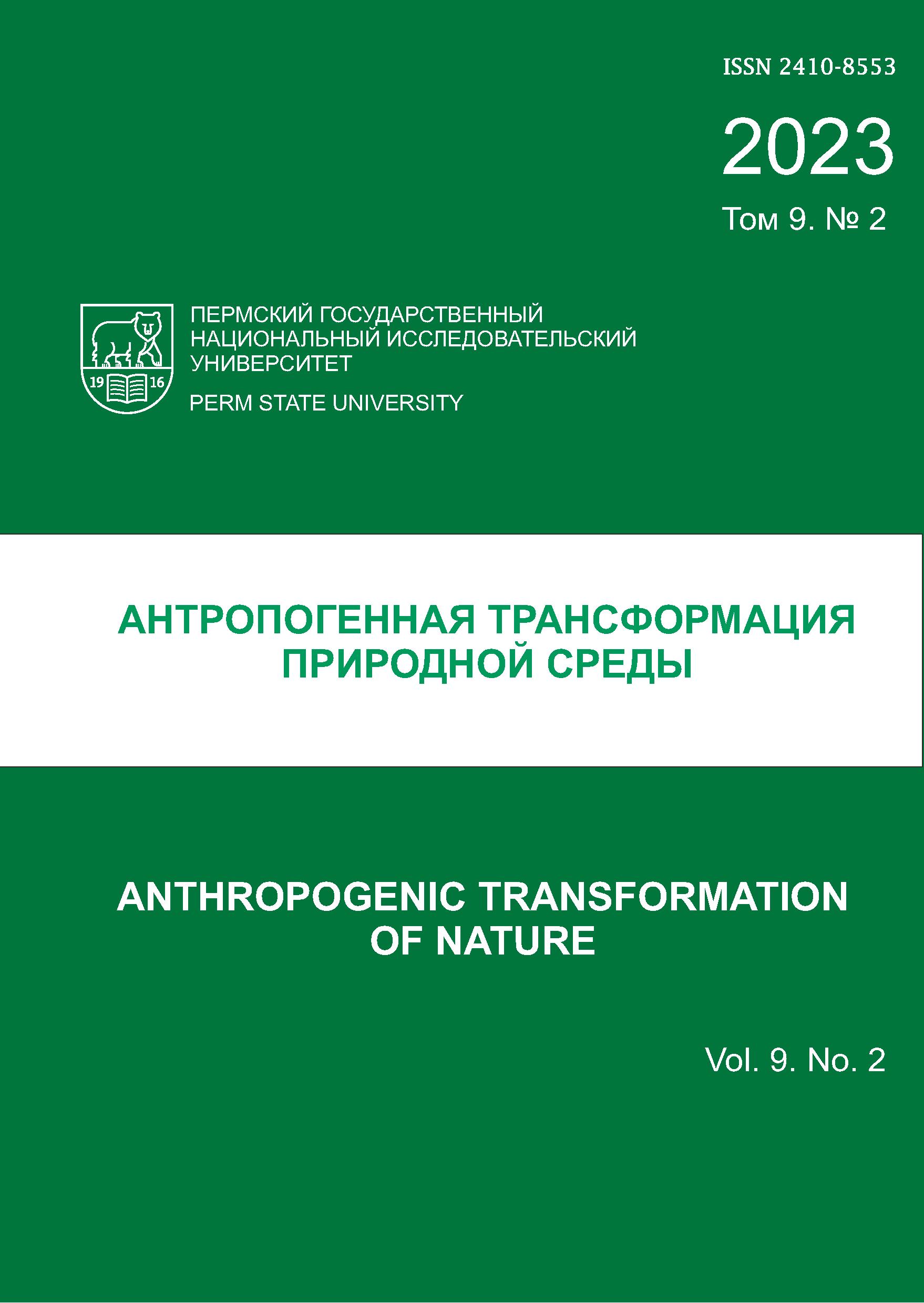Том 9 № 2 (2023): Антропогенная трансформация природной среды

Идут удивительные реформы в управлении вузами. Высшее образование в ходе реформ оптимизируется. Но это пока неважно.
В разделе «Сохранение природной среды» представлены: методическая статья для определения природоохранной ценности ООПТ; оригинальное сообщение по предложению о включении в состав системы ООПТ города Перми одной из долин малых рек.
По тематике антропогенной трансформации предлагаются: статья с оценкой состояния атмосферного воздуха в долинах рек урбанизированных территорий и акваторий; аналитические обзоры по проблемам изучения антропогенной нагрузки на водные ресурсы и загрязнения окружающей среды полихлорированными бифенилами.
У нас новый автор – доктор географических наук Ирина Дмитриевна Рыбкина. Выдающийся ученый в области природопользования и геоэкологии, социальной и экономической географии, оценки экологического состояния и качества окружающей среды, проблем использования водных ресурсов. Ведущий специалист в Сибири по оценке антропогенной нагрузки на водосборные территории и водные объекты речных бассейнов Оби и Иртыша. Имеет свыше 200 научных публикаций, в том числе 14 авторских и коллективных монографий, более 40 статей в научных журналах и еще в составе коллектива исполнителей участвовала в создании паспорта климатической безопасности Алтайского края.
Длительный период (несколько лет) известные деятели охраны природы Павел Юрьевич Санников и Павел Николаевич Бахарев совместно разрабатывали и корректировали методику оценки значимости ООПТ для сохранения природной среды. Теоретические компетенции первого и практический опыт второго позволили создать уникальную методику, в которой на основе открытых данных оценивается роль ООПТ в сохранении ландшафтного разнообразия, биологического разнообразия, экологического равновесия на глобальном, российском и региональном уровне.
На глобальном уровне значимость определяется по принадлежности к биогеографическим провинциям, экорегионам, очагам биоразнообразия. Такие районирования проводены Международным союзом охраны природы, Всемирным фондом дикой природы. Для России (на федеральном уровне) наиболее значима схема деления на физико-географические страны и природные зоны. Во второй части статьи методика реализуется на примере заповедника «Вишерский». Делается ожидаемый вывод о самой ценной ООПТ в Пермском крае по всем рассматриваемым показателям.
Большой коллектив исследователей (Бузмаков С.А., Кувшинский И.А., Шестаков И.Е., Абдулманова И.Ф., Кучин Л.С., Исаков Д.С.) провел лето в экологических изысканиях на реке Большая Мотовилиха. Орнитолог, геоботаник, почвовед, геоэкологи и экологи, каждый из них выполнил свое задание и интегрировал его в общее исследование. В результате обследования и обработки результатов, в ходе обсуждения авторы приходят к выводу о необходимости создания ООПТ в долине реки Большая Мотовилиха. Оптимальная категория – охраняемый ландшафт. Перевод территории в особо охраняемую нужен для создания экологического каркаса города, сохранения редких почв, флоры, орнитофауны восточной оконечности г. Перми. Организация ООПТ в долине Большой Мотовилихи позволит также обеспечить сохранение лесных экосистем; будет способствовать улучшению качества воздуха в жилых массивах за счет снижения поступлений загрязняющих веществ от потоков автотранспорта, движущихся по восточному обходу г. Перми. Экосистемы долины обеспечивают экологическое равновесие значительной части водосборного бассейна и нижележащей ООПТ «Мотовилихинский пруд».
Ольга Сергеевна Клочихина поддерживает свою компетенцию по знанию, умению и владению, очевидно, прекрасного научного английского языка и геоэкологических проблем загрязнения атмосферного воздуха в долинах малых рек города Перми. Для оценки качества воздуха были выбраны посты наблюдений, располагающиеся вблизи долин малых рек, в пониженных формах рельефа, которые способствуют накоплению различных примесей в атмосферном воздухе.
Ирина Дмитриевна Рыбкина показывает, что в современных научных исследованиях антропогенную нагрузку определяют, как меру количественного измерения влияния человека на аквальные ландшафты. Автор выделяет два современных методологических подхода – географический и гидрологический. Будем надеяться, что скоро появится и геоэкологический. Описаны виды воздействий, вносящие значительный вклад в антропогенную трансформацию водоемов: русловое регулирование, орошаемое земледелие, переброски стока, промышленно-коммунальное и сельскохозяйственное водоснабжение, осушение болот и заболоченных земель, вырубки и посадки леса, урбанизация. Обсуждены особенности использования и достоверность применяемых показателей в оценках антропогенной нагрузки. Обобщены имеющиеся сведения и исходная информация для оценки эффективности водопользования.
Дарья Олеговна Егорова – выдающийся исследователь разнообразия аэробных бактерий на экосистемном, популяционном, организменном и молекулярно-генетическом уровнях. Микроорганизмы, которых она изучает, обладают феноменальной способностью трансформировать химические поллютанты антропогенного и природного происхождения. Как правило, пользуется современными молекулярно-генетическими и биохимическими методами, а также методами классической микробиологии. Уже есть опыт выполнения работ в области бактериальной деструкции полихлорированных бифенилов, их химически-модифицированных производных.
У Дарьи Олеговны дебют в журнале. Она подготовила полноценный обзор по проблеме загрязнения окружающей среды полихлорированными бифенилами – соединениями, включенными в рамках международной конвенции в список Стойких органических загрязнителей. Показаны особенности строения полихлорбифенилов, их взаимодействия с окружающей средой и живыми организмами. Основное внимание уделено аэробным бактериям, одному из основных компонентов микробиоценоза почв. Считается, что длительное воздействие полихлорбифенилов привело к преимущественному отбору в загрязненных биоценозах бактерий, способных использовать полихлорированные бифенилы как источник углерода и энергии. Активные штаммы послужили основой для разработки уникальных биотехнологий.
Главный редактор, С.А. Бузмаков.
Опубликован:
2023-12-06
